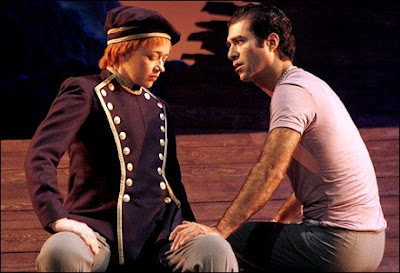
Twelfe Night, Or What You Will
Directed by David Esbjornson
Seattle Repertory Theatre
Seattle, WA
Oct. 3, 2007
Last Wednesday I went into Seattle to the Seattle Rep to a matinee of Twelfe Night [sic - just to be clever SRT uses the spelling from the First Folio, ] — I worried it would be in modern dress, but it was in eclectic theater costumes, a bright yellow suit here (Sir Andrew), Russian soldiers’ jackets there (Orsino’s followers), breathtaking velvet ball gowns for Olivia.
I would say I was the youngest person in the audience, until I noticed a couple of crocodiles of school kids, some ordinary scruffy sophomores not certain it was worth a day out of study hall, and twenty or so from Providence Classical Christian School (whom I thought to engage in a debate about oxymorons, Hellenic vs. Hebraic and all that, but the lights winked on for the second act), the latter in uniforms blue and gray, with the school crest over their hearts—nota bene SPA.
I was in row C, seat 7 in front of a breathtaking abstract set reaching 50 feet (?) or more up. Weathered planks the width of the stage, suggestively shattered in a couple of places (think shipwreck for a moment), a slightly raked acting area backed by a ridge or wave of the same planks, a tall twisted flat spire in the same planks, ragged at the ends, rising forty or so feet in front of the cyclorama. Gee, it’s really hard to describe an abstract set other than to say it was powerfully effective. Two ladies’ voices in the row behind me admired it, and one said if she were to come back for another life, it would be as a set designer.
Anyway, the play opened with an ornately made-up Feste, in a non-glaring spot on the apron, chanting the first three verses of “When that I was and a little tiny boy,” stage right a black-gowned Olivia bent in silent prayer over a flower-covered coffin, blue light and bubbles on the cyclorama, and the Captain and Viola, in sea-bedraggled clothes, “sinking” on ropes from the gods and, when they made landfall on the beach, he carried her off, and then Orsino appeared center stage through a door in the spire-thingee with a declamatory “If music be the food of love.”
Maybe not definitive, but I finished thinking it was top ten all time productions I’ve seen. Some curiosities: Fabian inexplicably was costumed as a flaming transvestite, fucia eye-shadow, a short black skirt and frilly blouse, but nothing in character or behavior made anything of this. The roistering scenes were excessive: Sir Toby had too many crotch-grabs and fart fannings, nor did I much cotton to Sir Andrew until he was clad in a suit of armor so heavy he could hardly walk for his duel with Cesario/Viola.
Mourning Olivia (Cheyenne Casebier) was severe, but after she is smitten she changed to a lively purple with flashy jewels and was effectively kittenish and coy. Viola handled the conflicted cross-gender duality powerfully (when Orsino is explaining love to Cesario there was almost a kiss).
Malvolio, an African American actor named Frank X (you can Google him as “actor Frank X” at the Lantern Theatre of Philadelphia) played an elegant English butler, until the M, O, A, I trick, after which he is grotesque, which is, I guess, appropriate. Then, he did remind me of a Snake (School for Scandal) I had seen in Ashland, also, curiously, an African-American. They cut down the Sir Topas torture (Malvolio was understage with his hands reaching up through bars) enough to get the spirit, but short enough that I was not uncomfortable.
For asides, there would be a spot on the speaker and the rest of the characters would be freeze framed in dimmer light. Very effective. For the first time, I noticed that Fabian setting on Augucheek is parallel to Maria and Toby setting on Malvolio. Very virile Sebastian, “twinned” to Viola by costume and red hair. Plausible with willing suspension. For the recognition scene, the cyclorama glowed violet.
At the end, Malvolio is in a straight jacket; Fabian pleads reasonably for forgiveness. Feste reprised his “little tiny boy” and curtain calls. Here’s something interesting: the company came on in groups, and the four lovers were next to last, while Feste and Malvolio were the “stars.” For the first time ever, I, from row C, led a standing O, joined by those in the audience who were physically able to stand and clap at the same time. Good show.
Posted by Gil
Photo: Christine Marie Brown as Viola/Cesario and Barzin Akhavan as Orsino in the Seattle Rep's Twelfe Night. Photo by Chris Bennion.